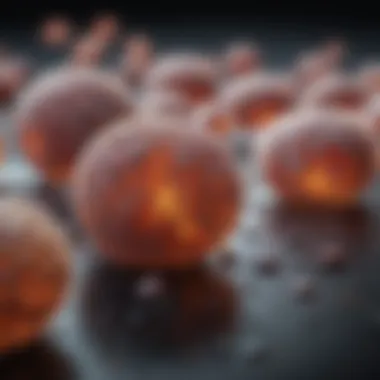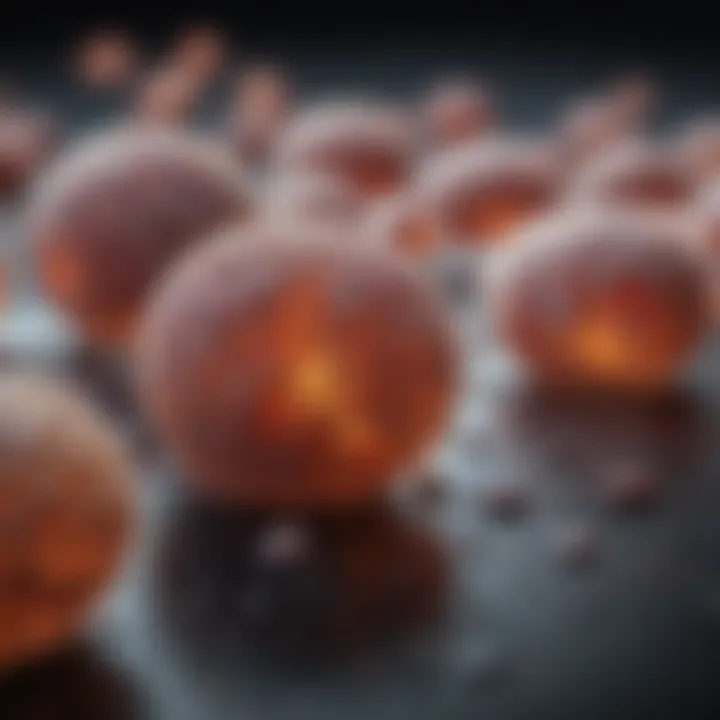Antimicrobials: Pioneering Advances in Science


Intro
Antimicrobials are substances that kill or inhibit the growth of microorganisms, primarily bacteria, fungi, and viruses. In modern science, their role is pivotal, not only in clinical settings but also in research and industry. The increasing prevalence of antimicrobial resistance (AMR) poses a significant threat to public health. Therefore, the exploration of antimicrobials becomes essential in understanding their mechanisms, applications, and future directions.
This article embarks on an in-depth examination of the role of antimicrobials in science. Throughout the discussion, we will explore the mechanisms of microbial resistance, developments in new antimicrobial agents, and the balance necessary between efficacy and safety in their use. Understanding these aspects will provide insights into both current challenges and advancements in this critical field.
Prelude to Antimicrobials
Antimicrobials play a critical role in contemporary medicine and scientific research. Understanding their significance goes beyond mere terminology; it involves recognizing their impact on health outcomes and disease management. Antimicrobials encompass a wide variety of agents that target microorganisms, including bacteria, viruses, fungi, and parasites. Their effective use can lead to substantial improvements in patient care and public health.
The importance of studying antimicrobials can be seen in various aspects. First, they are utilized as therapeutic agents to treat infections that can otherwise lead to serious consequences or death. Second, they contribute to surgical procedures where the risk of infection is significant. Third, they also play a pivotal role in preventing the spread of infections in both healthcare settings and communities.
As we explore the complexities surrounding antimicrobials, it is essential to consider not only their classifications and historical relevance but also the challenges posed by resistance and overuse. Through a deep understanding of antimicrobials, stakeholders in healthcare can devise strategies that ensure these vital agents remain effective in tackling infections.
Definition and Classification
Antimicrobials can be classified into several categories based on their origin, spectrum of activity, and target organisms. The primary classifications include:
- Antibiotics: These are naturally or synthetically produced substances that inhibit the growth of bacteria or kill them.
- Antivirals: Designed specifically to target viral infections, antivirals can inhibit viral replication.
- Antifungals: These agents are effective against fungal infections and work by targeting specific components of fungal cells.
- Antiparasitics: These are used to treat infections caused by parasites.
Understanding these definitions and classifications is crucial for selecting the appropriate therapy in clinical settings.
History of Antimicrobial Discovery
The history of antimicrobial discovery is a fascinating journey filled with scientific breakthroughs and discoveries. The first significant antimicrobial agent was penicillin, discovered by Alexander Fleming in 1928. This discovery heralded a new era in medicine, providing an effective way to treat bacterial infections.
Since then, numerous antibiotics have been identified and developed, each with unique properties and mechanisms of action. The 1940s and 1950s saw a proliferation of antibiotics, such as streptomycin and tetracycline, which expanded the range of treatable infections. The development of synthetic antimicrobials in the late 20th century further enhanced treatment options.
Today, the history of antimicrobial discovery serves as both an inspiration and a cautionary tale. The advancements achieved highlights the human capacity for innovation, while the emergence of antimicrobial resistance calls for sustainable practices in their use. The historical context provides insight into the current challenges faced in antimicrobial research and application, laying a foundation for future exploration in this critical area of science.
"The pace of discovery must match the pace of resistance to ensure a sustainable future for antimicrobials." - Unknown
Overall, a deeper understanding of the timeline of antimicrobials is essential for stakeholders to harness their potential effectively.
Mechanisms of Action
Understanding the mechanisms of action of antimicrobials is essential for appreciating their role in combating infections and managing disease. This section examines how these agents work to inhibit or kill pathogens, ultimately impacting their effectiveness in various medical contexts. A clear grasp of these mechanisms enables healthcare professionals to select appropriate therapies while also anticipating potential development of resistance.
Bactericidal vs. Bacteriostatic
Antimicrobials can be classified based on their effects on bacteria into two main categories: bactericidal and bacteriostatic. Bactericidal agents actively kill bacteria, achieving their effect through various modes of action such as disrupting cell walls or interfering with vital cellular processes. Examples include penicillins and cephalosporins, which target the bacterial cell wall synthesis.
In contrast, bacteriostatic agents merely inhibit bacterial growth and reproduction without directly killing the microorganisms. Agents like tetracyclines and sulfonamides block protein synthesis or metabolic pathways, allowing the host's immune system to eliminate the pathogens over time. The balance between these two types is crucial when selecting treatment options, as some infections may require immediate bacterial eradication, while others can be managed through growth inhibition.
"The choice between utilizing a bactericidal or bacteriostatic agent can significantly influence patient outcomes and guide effective treatment strategies."
Targeting Cell Structures
Antimicrobials utilize different strategies to target various cellular structures of bacteria. This targeting is predominantly determined by the drug's chemical composition and mechanism of action.
- Cell Wall: Many antibiotics, like vancomycin, specifically target the biosynthesis of the bacterial cell wall, which is unique to bacteria. Disruption of this structure leads to cell lysis and ultimately the death of the microorganism.
- Nucleic Acids: Some agents, such as fluoroquinolones, interfere with DNA replication and repair. By inhibiting topoisomerases, these drugs prevent cell division and associated cellular functions.
- Protein Synthesis: Antibiotics like chloramphenicol and aminoglycosides act on the ribosomal machinery within bacterial cells. They disrupt translations, leading to a halt in protein production, which is vital for bacterial survival.
Finally, understanding how antimicrobials target these structures helps researchers develop novel agents, refine existing treatments, and minimize the chances of resistance development. This ongoing research is essential for maintaining effective healthcare practices in a world increasingly challenged by antibiotic resistance.
Resistance Development
Antimicrobial resistance (AMR) poses a significant challenge in modern medicine. The emergence of resistant strains has serious implications not only for individual patient outcomes but also for public health at large. This section explores the mechanisms through which resistance develops and the consequences of overusing antimicrobials. Understanding these factors is essential for formulating effective strategies to combat resistance and promote responsible antimicrobial use.


Mechanisms of Resistance
Genetic Mutations
Genetic mutations are a primary driver of microbial resistance. These changes in the DNA of bacteria and other pathogens can lead to alterations in their structures or functions. For instance, mutations might affect target sites for antimicrobial agents, rendering these treatments less effective. One critical characteristic of genetic mutations is their ability to occur spontaneously during replication. This natural variability allows some organisms to survive drug exposure, creating a population that is increasingly resistant.
The benefit of focusing on genetic mutations in this article lies in their direct relevance to antimicrobial development. By understanding these mutations, researchers can tailor new agents that target resistant strains specifically.
However, there are also disadvantages. Overreliance on understanding genetic mutations might overshadow other mechanisms of resistance. Also, these mutations can sometimes lead to unexpected resistance profiles, complicating treatment approaches. A thorough examination of these mutations is vital in the quest against AMR.
Horizontal Gene Transfer
Horizontal gene transfer (HGT) plays a significant role in the spread of resistance among microbial populations. This process involves the transfer of genetic material between organisms, which often occurs in environments where antibiotics are prevalent. A key characteristic of HGT is its potential to facilitate rapid dissemination of resistance traits across different species. Unlike genetic mutations that arise within a population, HGT allows for quick acquisition of resistance from other organisms.
The discussion of horizontal gene transfer is crucial in this article because it highlights how resistance can develop and spread beyond individual species. The unique feature of HGT is its ability to cause sudden shifts in resistance patterns, thus complicating treatment strategies for clinicians.
However, HGT also presents challenges. The mobility of resistance genes means that one resistant strain can affect many others, leading to widespread resistance and making it a public health concern. Understanding HGT is essential for predicting and managing outbreaks of resistant infections.
Impact of Overuse
The overuse of antimicrobials remains a critical factor in the development of resistance. When antimicrobials are used indiscriminately, it creates an environment that selects for resistant strains. Common practices leading to this overuse include:
- Inappropriate prescriptions: Often, antibiotics are prescribed for viral infections where they are ineffective.
- Agricultural use: In livestock and poultry, antimicrobials are used not just for treatment but also as growth promoters, leading to increased resistance in animal populations.
- Self-treatment: Individuals sometimes use leftover antibiotics, leading to incomplete courses that do not fully eradicate infections.
The consequences of overusing antimicrobials are profound. As resistance spreads, treatment options become limited, leading to more severe infections, prolonged hospital stays, and increased healthcare costs.
Preventing the overuse of antimicrobials requires a collaborative effort within the healthcare community. Antibiotic stewardship programs can play a vital role in educating both prescribers and patients about appropriate antimicrobial use.
"Antimicrobial stewardship is an essential strategy in combating AMR and improving patient outcomes."
In summary, understanding resistance development through mechanisms like genetic mutations and horizontal gene transfer, along with the impact of overuse, is crucial for addressing the complexities surrounding antimicrobial resistance. This knowledge sets the foundation for more effective strategies to combat infection and manage public health risks.
Current Challenges in Antimicrobial Use
Antimicrobial use plays a critical role in modern medicine. However, there are significant challenges that impact its effectiveness. These challenges can lead to increased morbidity and mortality, as well as a growing burden on health systems. Understanding these challenges is vital for developing effective strategies to improve antimicrobial use and, by extension, public health outcomes.
Emerging Pathogens
Emerging pathogens are a primary concern in antimicrobial usage. These pathogens often differ from well-known bacteria, viruses, and fungi, making them harder to treat. Changes in environmental factors, human behavior, and global travel can lead to the rise of these pathogens. Their emergence raises crucial questions about current treatment protocols and the effectiveness of existing antimicrobials. As they proliferate, they can often display resistance to standard treatments, necessitating the development of new strategies and medicines.
- Some of the factors contributing to the rise of emerging pathogens include:
- Climate change, which can alter the habitats of organisms.
- Increased urbanization, facilitating easier transmission.
- Antimicrobial misuse, allowing pathogens to evolve quickly.
The ability of pathogens to adapt and resist treatment complicates the landscape, underscoring the need for ongoing research and monitoring.
Infection Control Practices
The effectiveness of infection control practices directly influences the efficacy of antimicrobial treatments. Proper implementation of these practices can significantly reduce infection rates and the need for antimicrobials, thereby decreasing the likelihood of developing resistance.
Antibiotic Stewardship Programs
Antibiotic Stewardship Programs (ASPs) represent a strategic initiative aimed at optimizing the use of antimicrobials. Their purpose is to ensure that patients receive the appropriate drug, at the correct dose, for the required duration. This is crucial for improving patient outcomes and reducing the adverse effects associated with antimicrobial use.
- Key characteristics of ASPs include:
- Evidence-based guidelines: These ensure that clinicians prescribe antibiotics correctly.
- Multidisciplinary approach: Involving pharmacists, microbiologists, and infection control experts enhances the program's effectiveness.
- Continuous education: Healthcare providers receive ongoing training regarding antimicrobial resistance and stewardship principles.
The unique features of ASPs make them a beneficial choice in optimizing antimicrobial use. They facilitate the reduction of unnecessary prescriptions, which is a significant step towards addressing resistance issues.


Hospital Acquired Infections
Hospital Acquired Infections (HAIs) are infections that patients acquire while receiving treatment for other conditions within a healthcare setting. They pose a significant challenge to patient safety and quality of care. These infections often result from a lack of rigorous infection control practices and can lead to extensive use of antimicrobials, inadvertently contributing to resistance.
- Key characteristics of HAIs include:
- Increased morbidity rates: Patients who acquire HAIs often face prolonged hospital stays and increased healthcare costs.
- Diverse pathogen involvement: HAIs can be caused by various organisms, complicating treatment.
- Need for improved practices: Addressing HAIs requires diligent infection control protocols and adherence to hygiene measures.
The unique nature of HAIs highlights their impact on antimicrobial usage. They underline the pressing need for effective infection control practices to prevent their occurrence and mitigate the reliance on antimicrobials.
Innovations in Antimicrobial Research
Antimicrobial research has rapidly evolved over the years, responding to the pressing need for effective treatments against resistant microorganisms. The topic is integral to our understanding and tackling modern health challenges. Innovations in this field not only contribute to overcoming existing resistance but also enhance the overall efficacy of treatment regimens. They bring with them numerous benefits, including the potential for less toxic alternatives and the ability to customize therapies based on patient needs.
Natural Antimicrobials
Natural antimicrobials are derived from various sources including plants, animals, and microorganisms. They have gained attention due to their ability to combat pathogens effectively while often presenting fewer side effects compared to traditional synthetics. Substances like essential oils, honey, and various herbal extracts possess inherent antimicrobial properties.
These compounds operate through diverse mechanisms, disrupting bacterial cell walls or inhibiting protein synthesis. Researchers have been focusing on isolating these substances to develop new treatments. For example, extracts from garlic and ginger have shown promising results against various bacteria and fungi. Exploratory studies are ongoing to better understand these natural compounds and their applications in modern medicine. The use of natural antimicrobials also aligns with a growing demand for sustainable and ecologically friendly practices.
Synthetic and Semi-Synthetic Options
On the other hand, synthetic and semi-synthetic antimicrobials have a significant role in addressing resistance challenges. These compounds are typically designed in laboratories to target specific microbial pathways, which can lead to enhanced potency. Notable examples are the development of penicillin derivatives and newer generations of cephalosporins.
These agents can be adapted to overcome known resistance mechanisms, providing a more robust approach against stubborn infections. Examples include the creation of beta-lactamase inhibitors which can protect existing antibiotics from degradation by resistant bacteria. The capabilities of semi-synthetic antimicrobials extend the function of their natural counterparts, often improving pharmacokinetic properties and broaden spectrum of activity. As research deepens, the focus will also include the cost-effectiveness and accessibility of these treatments, ensuring both healthcare systems and patients can benefit from their advancements.
"Innovations in the field of antimicrobials are crucial in the fight against global health threats and antibiotic resistance."
In summary, the innovations in antimicrobial research highlight the dual approach of utilizing both natural and synthetic materials. This balance not only addresses current resistance but also prepares the scientific community for future challenges in infectious disease management.
Antimicrobial Resistance in Agriculture
Antimicrobial resistance is a growing concern in agriculture, as it directly impacts public health, food safety, and ecosystem sustainability. In recent years, there has been increased awareness regarding the use of antimicrobials in livestock production. The application of these substances aims to prevent and treat infections in animals while enhancing growth rates. However, this practice has significant implications for the development of resistant bacteria.
Use of Antimicrobials in Livestock
The livestock industry relies heavily on antimicrobials. They help control diseases and manage health in farm animals. Some studies suggest that about 70% of all antimicrobials sold in the United States are used in agriculture. This usage raises concerns about the potential for resistance to evolve. The administration of these drugs can lead to the selection of resistant organisms, which may then spread to humans through the food chain or via environmental pathways.
For instance, a common practice involves administering low doses of antimicrobials preventively to healthy animals. While this can keep animals healthy and improve production efficiency, it also creates conditions conducive to developing resistant strains.
Environmental Impact and Sustainability
The environmental consequences of antimicrobial use in agriculture cannot be overlooked. These impacts have both direct and indirect effects, extending beyond farm boundaries into broader ecosystems.
Runoff Effects
Runoff can carry antimicrobials into water bodies, leading to contamination of lakes, rivers, and streams. This contamination poses a risk not only to aquatic life but also to human health. Resistance genes can transfer between bacteria, resulting in new strains resistant to multiple drugs. The runoff can contain not only antimicrobials but also resistant bacteria, creating an urgent concern for water quality and public health.
The key characteristic of runoff effects is their widespread reach. Once antimicrobials enter the water system, they can affect distant ecosystems. Minimizing runoff is crucial due to its potential to impact entire ecological communities, posing risks that are hard to predict.
Biodiversity Considerations
Biodiversity is significantly affected by agricultural practices involving antimicrobials. The use of these substances can lead to shifts in microbial populations in the soil and water, ultimately affecting flora and fauna. A diverse range of organisms is essential for ecosystem health, and the loss of biodiversity can disrupt ecological balances.
Biodiversity considerations highlight not just the biological richness but the resilience it offers to ecosystems. Healthy ecosystems can better withstand the pressures of change, including the introduction of resistant microbes. Thus, maintaining biodiversity becomes not only an environmental aim but a strategy to counteract the adverse effects of antimicrobial resistance.
In summary, the intersection of antimicrobial use in agriculture and the environment is intricate. Responsible practices must be adopted to enhance sustainability while addressing resistance issues. Efforts in research, policy, and public awareness are crucial to tackling these challenges.
Public Health Implications


The implications of antimicrobials on public health are profound and far-reaching. As these agents intervene in the fight against infectious diseases, it is critical to grasp how their use shapes health outcomes globally. An understanding of public health implications extends beyond immediate clinical applications. It encompasses factors such as antibiotic resistance, access to treatments, and the intersection of these elements with societal health systems.
Global Health Threats
Antimicrobial resistance (AMR) stands as one of the most significant threats to global health today. The World Health Organization (WHO) has highlighted AMR as a critical concern, predicting it could lead to ten million annual deaths by 2050 if no significant actions are taken. Each year, infections caused by resistant microbes result in substantial health care costs and increased morbidity.
The rise of resistant strains translates to longer hospital stays, more intensive care, and the necessity for more expensive medications. Moreover, common procedures, such as surgeries or cancer treatments, become riskier without effective antimicrobials. Doctors might face a dilemma in treating infections that were once easily manageable.
Some crucial factors contributing to AMR include:
- Over-prescribing of antibiotics by healthcare practitioners.
- Poor infection prevention and control in health facilities.
- Insufficient access to clean water and proper sanitation in certain regions.
- Use of antibiotics in livestock farming, which contributes to environmental pollution.
Case Studies and Statistics
Examining the case studies offers concrete perspectives on the severity of antimicrobial resistance. For instance, a recent study conducted in India revealed that over 70% of bacterial infections in hospitalized patients were resistant to commonly used antibiotics. This underscores the urgency for concerted global action and more awareness about responsible antimicrobial use.
Statistical data provides further visibility into the problem. According to a report by the Centers for Disease Control and Prevention (CDC), at least 2.8 million infections due to antibiotic-resistant bacteria occur every year in the United States alone, leading to a minimum of 35,000 deaths.
Some notable case studies include:
- Ninety-One Percent Resistance in Klebsiella pneumoniae: A study showed that resistance in a strain of this bacterium has surged dramatically in Latin America.
- Fighting Resistance in Europe: European health organizations are working to combat resistance through enhanced surveillance and strict guidelines for antibiotic use.
The challenge of antimicrobial resistance needs immediate and sustained action on a global scale.
The public health implications of antimicrobial use demand a multifaceted response. This includes enhanced research into new therapeutic alternatives, education about prudent use of existing drugs, and a collaborative approach aimed at minimizing the prevalence of resistant strains. Awareness and proactivity in addressing these public health threats are vital for safeguarding the health of future generations.
Future Directions in Antimicrobial Research
In the evolving landscape of science, future directions in antimicrobial research are critical. The fight against microbial resistance is not just a medical issue; it encompasses various disciplines, including ecology, pharmacology, and microbiology. Understanding how to innovate in this field can lead to significant advancements in public health and well-being. This section aims to detail two key areas: personalized medicine approaches and interdisciplinary collaboration.
Personalized Medicine Approaches
Personalized medicine represents a transformative approach in healthcare, focusing on tailoring treatment to individual characteristics, needs, and preferences. In the realm of antimicrobials, this means creating targeted therapies that consider a patient’s specific microbial profile. The benefits of personalized medicine include:
- Enhanced Efficacy: By targeting the specific pathogen involved in an infection, personalized treatments can be more effective than broad-spectrum options.
- Reduced Resistance: Tailored therapies may lessen the chances of developing resistance, as they mitigate overuse of broad-spectrum antimicrobials.
- Improved Safety: Understanding individual responses to medications can minimize side effects and improve overall patient outcomes.
Efforts in genomics and microbiomics are pivotal for achieving personalized medicine. By analyzing the genetic makeup of pathogens, researchers can develop drugs that are specifically designed for certain strains. This method is gaining traction, especially in treating infections that are stubborn and resistant to existing drugs.
Interdisciplinary Collaboration
Collaboration across disciplines is increasingly crucial in antimicrobial research. It brings together experts from varied fields, including biology, chemistry, engineering, and even social sciences, to tackle complex challenges. The significance of interdisciplinary collaboration includes:
- Innovative Solutions: Combining knowledge from different fields can lead to innovative antimicrobial strategies that may not emerge in siloed research environments.
- Broader Perspective: Drawing insights from other areas can identify risk factors and behavioral issues related to antimicrobial use and resistance.
- Resource Sharing: Collaborative projects can pool resources, funding, and expertise, resulting in more significant research advancements.
A prime example of this collaboration can be seen in the development of nanotechnology solutions for drug delivery. Nanoparticles can help deliver antimicrobials more effectively, improving penetration into biofilms and resistant bacterial populations. Collaboration extends research capabilities and can lead to more rapid advancements.
The future of antimicrobial research hinges on adaptability and innovation, as the challenges posed by resistance evolve.
Finale
The conclusion of this article emphasizes the crucial role that antimicrobials play in both modern medicine and scientific research. Antimicrobials are indispensable in controlling infections and shaping public health outcomes. As we have explored in previous sections, their effectiveness is often challenged by the emergence of resistant strains of bacteria. Therefore, understanding the pivotal points surrounding antimicrobials is essential for future advancements in medicine.
Summary of Key Points
The key points presented throughout the article include:
- Definition and classification of antimicrobials: Antimicrobials are broadly categorized into various classes, including antibiotics, antifungals, and antivirals, each serving distinct functions.
- Mechanisms of Action: Understanding how these agents work helps in developing new therapies and strategies to combat resistance.
- Resistance Development: Awareness of genetic mutations and horizontal gene transfer is vital to address the challenge of antimicrobial resistance effectively.
- Current Challenges: Emergent pathogens and infection control practices highlight the necessity of sustainable antimicrobial usage.
- Innovations in Research: Progress in natural and synthetic antimicrobial agents indicates a promising future for developing effective treatments.
- Public Health Implications: The statistic and case study analysis underlines the global health threats posed by antimicrobial resistance.
- Future Directions: Emphasis on personalized medicine approaches and interdisciplinary collaboration is fundamental for innovative solutions in antimicrobial research.
Call for Action in Antimicrobial Stewardship
To mitigate the escalating issue of antimicrobial resistance, it is imperative to advocate for effective antimicrobial stewardship. This means that healthcare providers, researchers, and policymakers need to:
- Educate Health Professionals: Training should focus on appropriate prescribing practices and the importance of infection prevention measures.
- Implement Antibiotic Stewardship Programs: Hospitals and clinics must develop protocols that promote the judicious use of antimicrobials in both human and veterinary medicine.
- Enhance Research Funding: Increased financial support for research targeting new antimicrobials and alternative therapies can lead to more effective treatment options.
- Promote Public Awareness: Engaging the general public through campaigns that highlight the importance of responsible antimicrobial use is essential for changing perceptions and behaviors.
"Antimicrobial stewardship is not just a healthcare issue; it is a global challenge that requires collaborative efforts to protect lives across communities."



